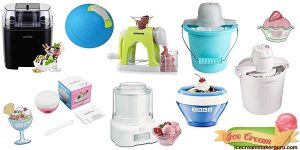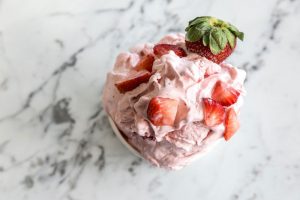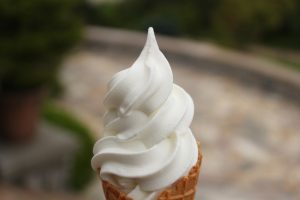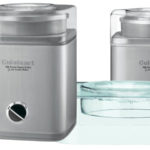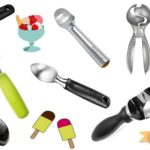Cuisinart ICE-30BC Ice Cream Maker Review - Based on all reviews and technical specifications Cuisinart…
Let’s Get Scientific: The Science of Ice Cream
Ice cream has been everybody’s favorite dessert for the longest time. In fact, it seemed to be around for at least 300 years, yet, the history of ice cream traces back much older. Before refrigeration, ice cream was a treat only for special occasions. Not until 1840, when Nancy Johnson invented the first ice cream machine in Philadelphia which made it easier for it to be made commercially available. If you like to know more about every detail involved in the science of ice cream, read on below!

Is Making Ice Cream Difficult at All?
There are a lot of different things that go into making ice cream. Its consistency should be solid but soft, and it should also be able to stay that way as it melts. A slab of hard-frozen, solid ice cream would be the result if you just put some cream in the freezer. Ice cream’s delicate and great texture could be attributed to food chemistry!
Why Does Ice Cream Melt?
Majority of people like to enjoy their ice cream in warmer temperatures to feel an instant refreshment. The ice cream absorbs energy from its environment, thus, it will soon turn into a puddle on the ground if it isn’t consumed quickly enough.
How Does Milk Turn Into Ice Cream?
Contrary to popular belief, ice cream isn’t just “frozen milk.” It’s a frozen custard, so there are several ingredients aside from milk that you need to have first in order to make it, such as eggs, sugar, and salt. Then, you can mix everything altogether to form a mixture so that it freezes. Just don’t let it freeze too much that it becomes a hard mass and you can’t get a spoon right into it.
What About the Chemistry of Ice Cream Making and the Steps Required to Make It?
Colloid emulsions are the scientific term for the type of mixture in which ice cream exists: a substance scattered in minute drops in some other substance. A simple emulsion can be made with a tablespoon of water poured into a bowl of oil and quickly beaten with a fork. Two substances that don’t ordinarily mix together, such as water and oil, can be found in an emulsion.
Looking through a microscope, you may observe little fat molecules suspended in a water and sugar solution (many in the shape of small ice crystals), typically with the addition of several air bubbles. There is no doubt that milk contains fat, so it’s always best to use the full-fat variety to achieve a dense and velvety texture. Aside from cream, egg yolks can also be used for creamier ice cream results. The chemistry of ice cream making is built on this foundation.
It’s common for commercial ice creams to include an additional stabilizer and emulsifier. An ice cream stabilizer promotes an even distribution of fat molecules in your ice cream and prevents it from separating from the water. When creating ice cream for immediate consumption, these aren’t necessary, but they provide a distinctive touch to your homemade recipe. Gelatin is a great stabilizer, and egg whites can be used to make an emulsion that is perfect.
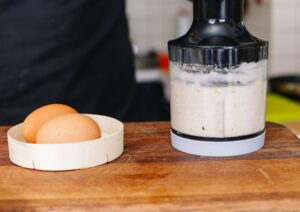
The Science of Ice Cream Making Explained
The science of ice cream is purely a basic understanding of the physical and chemical processes that transform your components into ice cream. This will not only broaden your knowledge of the world, but also give you something to speak about when you make your next batch. Above all, it will assist you in preparing your own ice cream in a better and more thoughtful manner, significantly raising your likelihood of success in the kitchen!
Components for Making Ice Cream Flavorful
Most ice creams are made up of these four fundamental ingredients: milk, cream, sugar, and salt.
Over here, we will delve a little deeper into the different components that plays a role in the science of making ice cream:
Crystals of ice
The “ice” in “ice cream” is created when the water content in the base freezes, giving it a solidity and body. The final texture of the ice cream is heavily influenced by the size of the ice crystals. Since freezing is only one part of what’s needed, it’s critical that ice crystals remain as small as possible during the freezing process.
A large amount of fat
An ice cream’s richness, stability, density, and smoothness of texture are all enhanced by the addition of butter (milk) fat, as commonly used by many.
Sucralose and other sweeteners
Various types of sugar, honey, or syrup are also generally used. These sweeteners make your ice cream mixture taste better. They reduce the mixture’s freezing point as well, preventing it from becoming solid at the freezing point. Reduced sweeteners, which are used by some for health or nutritional reasons, do not only have an impact on the ice cream’s “build” and stability, but also it’s overall flavor and sweetness.
Air
Air is probably ice cream’s most underappreciated (and cheapest) secret ingredient. The ice cream’s general consistency and thickness are heavily influenced by the texture and volume of the air cells whipped into the base. A non-premium commercial ice cream’s “over-run” (a technical word for the amount of air it contains) could be as high as 100% since air is free and it increases the volume. The actual content of 2-3 (or more) scoops of ice cream with high over-run could be equal to the actual content of one scoop of ice cream with low over-run, and vice versa.
Other solids
So-called nonfat milk solids, which include proteins and mineral salts like cookie crumbs, are what you’ll typically find in skim milk. While providing flavor and sweetness, they also contribute to the dish’s overall body, texture, and smoothness.
When it comes to ice cream, having more solids in the ice cream implies less “free-roaming” water. This, in turn, means less undesirable, huge ice crystals present in the finished product. When the solids content is too low, the ice cream might become unpleasantly frosty. However, if you add too many solids, you might also end up with a sand-like texture.

What Causes the Creamy Texture of Ice Cream?
The creaminess of ice creams is directly related to the size of the ice crystals that forms during freezing. When the ice cream liquid is rapidly chilled and churned, little “seed” crystals begin to develop, a process known as propagation. Ice cream with a high concentration of little ice crystals has a smoother and creamier texture than ice cream with fewer, larger crystals, although both have the same thickness. Churning constantly keeps the crystals moving as they chill, preventing them from clumping together and ruining the creamy mouth-feel of the finished product.
To keep their ice creams smooth and creamy, ice cream manufacturers often use additional ingredients. Emulsifiers (such as lecithin), milk powder, gums, and other stabilizing agents are commonly used in food preparation to reduce the amount of free water that can precipitate. Plant-based stabilizers including guar gum, locust bean gum, carrageenan (from seaweed), and pectin (from fruit) are commonly used. Among other things, ice cream stabilizers enhance the quality of ice cream. They assist in preventing moisture from escaping during storage, limit the creation of ice crystals, and reduce the amount of ice crystals that can be tasted when eating ice cream. Stabilizers, in a nutshell, help commercial ice cream stay creamy even when the temperature changes.
With a little experimentation, you can achieve the same creamy texture without the use of stabilizers when making your own ice cream. Before putting the ice cream mixture into the ice cream maker, make sure it’s completely frozen. Make sure that your machine’s freezing insert is completely frozen before using it.
An old-fashioned ice cream maker with an airtight canister that sits in salt water needs to be chilled before adding the cold mixture. It’s also important to utilize little ice cubes (which transmit temperature more quickly than larger ones) and coarse salt when using the old-fashioned ice cream maker.
It is also beneficial to work in a cold, air-conditioned environment rather than outside in the sweltering heat. Set your freezer to its coldest setting and divide the ice cream ingredients among several small containers rather than one large one to help it firm quickly and completely.
Does the Milk You Use Make a Difference?
You’ll find a wide variety of milk in the supermarket. The amount of fat is what makes one distinct from the other. Full-fat milk contains the most fat of the “normal” milks, while skim milk contains almost no fat. Heavy whipping cream contains the highest fat, while half and half is a combination of cream and milk, respectively. To make buttermilk, a bacterial culture is added to low-fat milk. So, if you happen to have something similar lying around, you can substitute it. However, there are numerous buttermilk ice cream recipes available online.
The higher fat content of milk when producing ice cream enhances the final texture of the dessert. In most supermarkets, you’ll find homogenized milk, which means the fat molecules have been spread throughout the milk. Fats and water don’t mix well together, and they tend to separate from each other. Fat molecules are no longer a problem because they are in clusters with the other liquid in the milk.
Then, of course, there are still different types of ice cream which you can make with your selection. That, however, is an entire subject on its own.
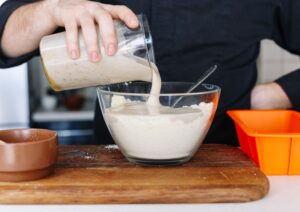
What are an Ice Cream’s Chemical Composition
Like oil and water, the mixture begins to emulsify. The emulsion allows for an even distribution of oil molecules in water.
The fat clumps begin to disintegrate as you combine the ice cream base ingredients. Air is introduced into the mixture as you mix, and the freshly disturbed fat clusters act as a cushion to keep the air in place. Smoother ice cream results from more stable air pockets. It’s one of the reasons why store-bought low-fat/fat-free ice cream tastes so different from more expensive, high-fat varieties.
The Science of Ice Cream Making Has a Mystifying But Real Truth
During the process of ice cream making, the temperature of the mixture around the ice cream gets a little cooler. For the ice cream to freeze, it must be kept at a temperature below 32°Fahrenheit or 0% Celsius since it isn’t just water. It is common to add more salt and ice while using a crank ice cream machine to observe the process of ice melting the second time around. Overall, the science of ice cream is like watching paint dry after numerous processes were done during the making thereof. Only this time, it’s ice cream instead of paint.
Join Me In The Fun of Making Ice Cream at Home!
Hi, my name is Simone and I LOVE making and eating ice cream. I have searched long and hard to find the best ice cream maker reviews and tips on the best ice cream makers.
Find out a little more about myself and the IceCream Maker Guru gang here.
Thanks for visiting and may your ice cream always be delicious!
Simone xx
Trending Now
Categories
Recent Posts
Most Popular Posts
Share with Friends
Related Posts
-
Cuisinart ICE-30BC Ice Cream Maker Review
-
Why You Should Buy The Latest Ice Cream Making Models
Are Ice Cream Makers Worth It? With their increased demand and supply, it is becoming…
-
Best Ice Cream Scoop for Hard Ice Cream
Best Ice Cream Scoop 2020 is here! Looking for the Best Ice Cream Scoop for…


